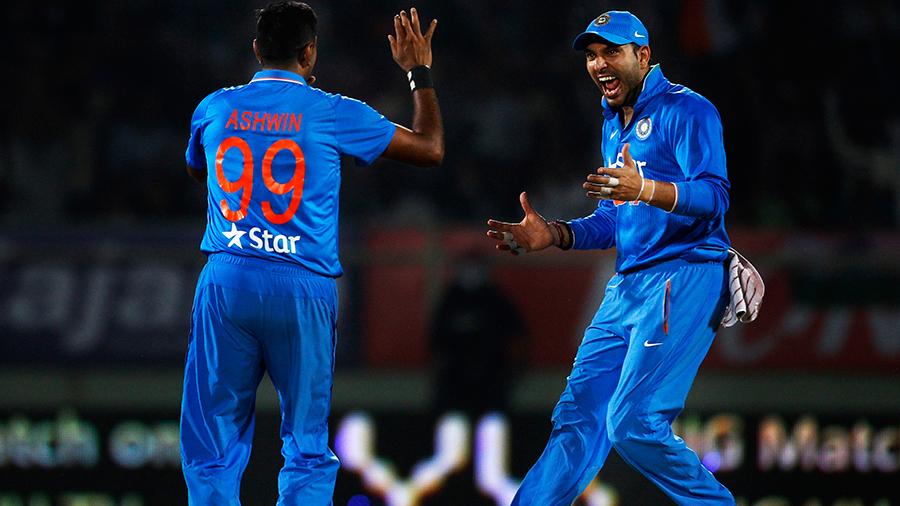March 24, 2016
“All comes down to today, and either, we heal as a team, or we're gonna crumble,” says Tony D’Amato, Al Pacino’s character in Any Given Sunday. “Inch by inch, play by play. Until we're finished.

March 24, 2016
“All comes down to today, and either, we heal as a team, or we're gonna crumble,” says Tony D’Amato, Al Pacino’s character in Any Given Sunday. “Inch by inch, play by play. Until we're finished.

“We're in hell right now, gentlemen. Believe me. And, we can stay here, get the shit kicked out of us, or we can fight our way back into the light. We can climb outta hell… one inch at a time.”
Three balls into the final over of the Super 10s encounter against Bangladesh at the Chinnaswamy Stadium in Bangalore, India were on the precipice, looking down into the inferno. Mushfiqur Rahim had smashed an awful wide delivery from Hardik Pandya for four, and the mistimed scoop to fine-leg that followed evaded MS Dhoni’s dive and raced to the rope. Three balls left, just two needed.
As soon as Mushfiqur saw that ball slip under Dhoni’s body, he was pumping his fists mid-pitch, and yelling excitedly. The young Bangladesh journalist sitting next to me in the press box mimicked his actions. Another, a sweet young man I befriended during the 2015 World Cup, patted me on the shoulder and said: “Your team played well to take it this far.”
But that was the point. Mushfiqur forgot, and so did my young friends, that the final inches hadn’t been traversed. Bangladesh still needed two from three balls. A cool head, rather than an adrenaline rush, was needed. In Mushfiqur, technically the most accomplished of Bangladesh’s batsmen, and Mahmudullah – whose composure in big matches has been such a big part of his team’s stunning improvement in the past 15 months – the visitors seemed to have men perfectly equipped to finish the task.
But pressure does funny things to people. Mushfiqur chose to slog a slower ball high towards deep midwicket, when a flat-batted stroke would have guaranteed him at least one with the field spread. But even as he trudged off, berating himself, Bangladesh remained in the box seat. The batsmen had crossed, and it was Mahmudullah and not Shuvagata Hom that had the strike.
After much consultation and deliberation, the ball that Pandya came up with was a low full toss. Like Mushfiqur a ball earlier, Mahmudullah too glimpsed glory over midwicket. But it was one of the longer boundaries to clear on an otherwise small ground, and he didn’t quite middle it.
Before the ball was bowled, Dhoni had thrown his fielding dice as well, removing Dhawan and replacing him with the jet-heeled Ravindra Jadeja. Even as the ball soared into the Bangalore night, Jadeja started running in. There was much to do, and his path to the swirling ball was far from being a straight one. But he cupped his hands skywards, pouched the ball and them tumbled without it escaping his grasp.
A stadium roared, and the balance was suddenly tilting in India’s favour. Hom had the strike, but India knew that keeping him to a single would guarantee them at least a Super Over. Dhoni, unlike the two batsmen now staring into space in the pavilion, refused to think that far ahead though.
His concern was the here and now, matters of inches. He knew the batsmen would run, regardless of whether Hom got bat to ball or not. He just had to make sure Pandya bowled the right ball, and that he was ready to thrown down the stumps.Cue another conference on the square. Pandya said later that the multitude of suggestions had made him laugh. A touch nervously, no doubt. Eventually, India decided on a back-of length delivery outside off stump. Pandya executed it perfectly. Hom swung and missed, but even as Mustafizur Rahman was haring towards the striker’s end to secure the tie, Dhoni was sprinting to the stumps to deny him and Bangladesh.
The greatest finisher that limited-overs cricket has seen prevailed. This time, he didn’t have a bat in hand. What he did have was presence of mind. A shy at the stumps might have missed. By running straight at them with his arms outstretched – a Jonty Rhodes-style Superman dive wasn’t required – Dhoni eliminated the margin for error.
There was desolation in the press box. Fist pumps and tight-lipped exhortations had given way to heads in hands and misery. Over the past year, this burgeoning rivalry has perhaps supplanted India-Pakistan in the nastiness stakes. Navjot Singh Sidhu’s ridiculous remarks after Bangladesh’s World Cup 2015 victory against England didn’t help, and the Rohit Sharma no-ball that wasn’t in the quarterfinal that followed triggered conspiracy theories and dramatics from Mustafa Kamal, who forgot that he was there as ICC President.
The subsequent war of words on social media has been little short of puerile. Most Bangladeshi fans, and elements of the media, have seen the banning of Taskin Ahmed and Arafat Sunny as further proof of India emasculating a neighbour. But however poor the timing of it, processes were followed, a fact borne out by the fact that Michael Beloff, the Queen’s Counsel that heard Taskin’s appeal, upheld the ban.
For now though, cross-border rivalries and the venom on message boards have been eclipsed by India’s Dhoni-engineered great escape. They will still most likely need to beat Australia to go through to a Mumbai semifinal, but by winning the game of inches, they’ve given themselves a half-decent chance.
“The inches we need are everywhere around us,” says D’Amato. “They're in every break of the game, every minute, every second. On this team, we fight for that inch. On this team, we tear ourselves and everyone else around us to pieces for that inch. We claw with our fingernails for that inch.”
On Wednesday (March 23) night, no one clawed harder than Dhoni, who stared into the eye of the tiger and didn’t blink.
Courtesy: Wisden India
















































































































